I'll leave aside the particulars of the scenario ideas themselves right now, as we're still working on them and have not yet made them available to the CRN Task Force members. I'd like to talk a bit about the process itself, and why this may end up being not just a functional alternative to traditional scenario workshops, but potentially a preferred approach.
Approximately 15 people participated in the CRN scenario event, including the two CRN leaders, Mike Treder and Chris Phoenix. I served as facilitator. The attendees represented a reasonably broad variety of disciplines and backgrounds, although all had sufficient interest in and knowledge of molecular manufacturing to be a part of the CRN discussion. Most resided in North America, but one participant attended from New Zealand, and another from Europe; we chose a start time that would be minimally-disruptive to the sleep of the broadest number of participants.
A Text Chat Channel, in this case the one built into Google Spreadsheets.
Read on to see how we did it.
The Process
Most of the content generation happened by voice, with conversations taking place via the conference call system. Rather than a cacophony of multiple speakers trying to get a word in edgewise, we went with a "raise your hand to speak" approach -- which is essentially what happens in an live workshop, as well, when you have more than five or six group members. This went quite smoothly, and people who were not speaking could mute their phones, reducing the interruptions of sneezes, mobile phone ringers and the like.
Chris served as scribe, and was the only one normally authorized to write into the Google Docs page. We asked the attendees to keep this page open, however, as it was important that they be able to correct any errors (in spelling, emphasis, or meaning) that Chris might make; this also served as a good way for attendees who might have stepped away for a moment to catch up. As the conversation ensued, Chris recorded the main ideas, and as many of the useful phrases or terms as he could -- this was not a transcript, but was certainly more than an outline.
Mike served as moderator for the online chat, and the router for voice questions. We used the Google Spreadsheets in a simple way, with a list of the names of the participants, a separate, changing list of who had asked to speak, and the built-in chat window (similar to IRC) as the participant channel.
Mike and I would watch the chat window, looking for comments indicating confusion or a need to comment. We asked anyone who had a question or observation to type HAND into the window, as an obvious signifier that they wanted to speak; Mike would then put their names into the second list, in order, putting the name in bold when the person was speaking, and deleting when done. Occasionally, if it seemed necessary or appropriate, I would call on someone directly when I saw either the HAND entry or a question/comment that seemed worth pursuing in group.
The chat window was, by far, the most useful and novel aspect of this exercise. Everything else mentioned above is, more or less, a parallel to a live event approach or tool. The chat window, however, does not have a parallel in the conventional scenario workshop (note: I recognize that back-channel discussion via wireless & laptop is commonplace in tech conferences, but in most scenario/futures events, attendees are asked to keep laptops closed to avoid distraction). This channel allowed attendees to make quick comments, add URLs, ask each other questions, and otherwise illuminate the primary, voice conversation. The audio channel could continue on, uninterrupted. In a live workshop, with voice the only mass conversation method generally available, any attempt to carry on a secondary discussion is typically met with glares and requests by the moderator for "one conversation, please." With the chat window, at no point did it appear that the text discussion was blocking or distracting the speaker.
Note that this is not the same as people firing off emails to each other, no matter how many people are CC'd. Inevitably, someone is left out of the loop -- usually the facilitator, at least -- and since email tends to arrive in clumps (as the server gets checked), it's much more likely that the reader will end up missing out on the voice discussion while reading a series of email messages. Chat is quick, transparent, and far less distracting. When email did get used in the course of the event, it was for quick "note-passing" between organizers (and, I presume, between attendees).
In terms of scenario methodology, this worked (by and large) like a straightforward GBN-style exercise. Brainstorming, clustering, voting, and the like, all worked reasonably well using the tools we had (although I would like to see if a multi-user "mind-mapping" application would work as a way of brainstorming & clustering). An attempt at a more "open mic" segment for working on the scenario narrative was less successful than the raise hand to speak method -- more than one person felt unable to get a word in, despite active attempts on the part of the moderator and myself to watch for that very problem. It was clear that the combination of voice & text was a far superior approach, as it allowed people who excelled in a particular medium to work to their strengths.
A particularly useful aspect of the virtual workshop method, from a post-event perspective, is the totally-digital nature of the result. No problems with getting flip charts transcribed, no trying to get photographs of notes people had put onto documents -- and no worries about forgetting what a given participant said, as the whole event can be downloaded as a digital audio file from the conference call system.
For a non-profit like CRN, one especially important aspect of all of the tools we employed was that they were all no-cost. Many non-profits have little funding for multi-user software systems, let alone flying a dozen people in from around the country and world. These kinds of tools allow for even the most shoestring operation to engage in effective, collaborative strategy & planning activity, no matter how far dispersed the members may be.
The Path Not Taken
We considered and tested alternatives to the voice conferencing system. My initial suggestion was one of the voice chat utilities used by multiplayer gamers, as these can support the necessary number of attendees, offer features such as secondary "rooms," and would be available to international users at no additional charge. Upon testing, however, we discovered that the latency between saying something and the others hearing it was just great enough for people to start talking over each other, stop, start to talk over each other (thinking the other had paused), stop, ad infinitum, ad nauseum. The protocols we ended up deploying for voice conversation may mitigate that problem, however, so we will likely be testing this set-up again.
Skype and other VOIP systems had problems of scalability (number of attendees), privacy, and/or platform (we needed to be able to work on Windows, Mac and Linux).
We initially considered setting up the Google Docs whiteboard as a fully-shared space, but too many people simultaneously editing the document resulted in far too much text "jumping around," leading to mis-entered content. We chose to use a single scribe (Chris), with a few others occasionally making small changes or additions to the page with fore-warning.
It might be useful to have a secondary shared doc as a group scribble board, but that butts up against logistical issues of screen space.
Finally, we briefly considered using an immersive 3D world for this, such as Second Life, but decided that the learning curve would be enough that the first few tries would be all about trying to figure out the interface. As these technologies mature, we'll likely revisit this idea.
Infrastructure
The tools necessary for this event were essentially just a phone line and an Internet-connected computer.
We used FreeConferenceCall.com for the voice conversation, and it worked well. It does not have toll-free numbers, but the growing popularity of flat-rate long distance plans (especially on mobile phones) makes the use of a toll number for a call a non-issue. The conference call site was based in the US, so international callers did face a higher rate; fortunately, our European attendee was able to use Skype to three-way-call a US attendee, then join his connection to the conference.
On the computer side, the tools we used were quite simple, and required only a recent web browser for live updates of content. By and large, the faster the connection, the better, but this setup should work with even a modem hookup. That won't be true if/when we use a voice over IP setup like TeamSpeak or Ventrilo; these require a broadband connection, and a relatively capable computer.
The two pieces of hardware that I found to be the most useful were a lightweight headset for the phone (I couldn't imagine trying to hold a regular phone to my head for five hours, and speakerphones would degrade the sound quality) and an extra-wide monitor (or, in my case, a big monitor hooked to a Macbook with its screen open, allowing for dual-screen use).
Conclusions
I would most definitely use this process again. No travel in cramped seats on CO2-spewing flying tubes, no sleepless nights on a lumpy hotel bed, no trying to decide if the suit jacket is too wrinkled. I had all of my resources at my fingertips, and (since I work at home) the ability to pop into the kitchen as needed. As indicated in the subtitle to the piece, I could even run the workshop in my pajamas.
While it was a shame not to be able to have easy side-discussions with attendees during breaks, I didn't feel like there was significant distance between myself and the group during the event itself. The fact that I couldn't see whether they were looking away or had slipped out to the bathroom didn't have an appreciable impact, as the ongoing chatter in the backchannel window was a good proxy for level of engagement. The use of HAND to indicate a desire to speak kept the number of interruptions to a minimum, so that frequent speakers weren't quite so dominant over the more occasional participants (who, as noted, were often much more "vocal" in the text chat).
The computer tools worked about as well as we hoped, and while there are certainly ways we could make better use of them (pasting images and graphs into Google Docs, for example), the only limit I felt in their use was based on the lack of screen real estate for most users -- I would have loved to have had one or two more documents open as a middle-ground between the scribe's record and the chat window.
The real question, I suppose, is whether a client would want this. The CRN folks seemed pretty happy with it, but how would an organization accustomed to in-person workshops respond to the idea of everyone sitting around in different places, on phones and text chat? Would that feel less serious? Less like work? Or, conversely, would it feel too much like the day-to-day grind of making phone calls and updating documents?
I don't see this as a replacement for in-person workshops, I suppose, but as complements. Do a first meeting virtually, for getting everyone up to speed. Do a second in person, with the usual social bonding and business networking opportunities. Do the follow-up virtually, as the participants will now have a good working relationship, and see this not as a toy, but as a tool.
I'd give that a try.
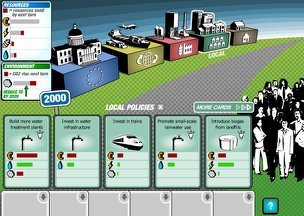 Multiple deadlines this week, plus meetings -- but interesting stuff keeps rolling in.
Multiple deadlines this week, plus meetings -- but interesting stuff keeps rolling in.

 Bruce Sterling's
Bruce Sterling's  Let's see, lots of apocaphilia lately...
Let's see, lots of apocaphilia lately...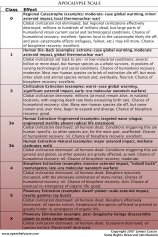
 My good friend and colleague
My good friend and colleague  Damn, that iPhone is pretty.
Damn, that iPhone is pretty. The Cheeseburger Steamroller continues, as I show up on Treehugger radio (playing online and on Air America) talking about the cheeseburger footprint story. The conversation is actually excerpted from a much longer description of how and why I undertook this investigation. The folks at TH tell me that they're going to put that longer audio clip up either later today or tomorrow.
The Cheeseburger Steamroller continues, as I show up on Treehugger radio (playing online and on Air America) talking about the cheeseburger footprint story. The conversation is actually excerpted from a much longer description of how and why I undertook this investigation. The folks at TH tell me that they're going to put that longer audio clip up either later today or tomorrow.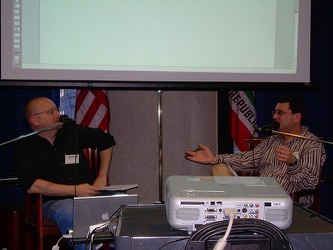
 The "
The " (Jon Lebkowsky, over in the
(Jon Lebkowsky, over in the 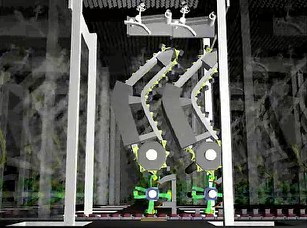 (Cue "
(Cue "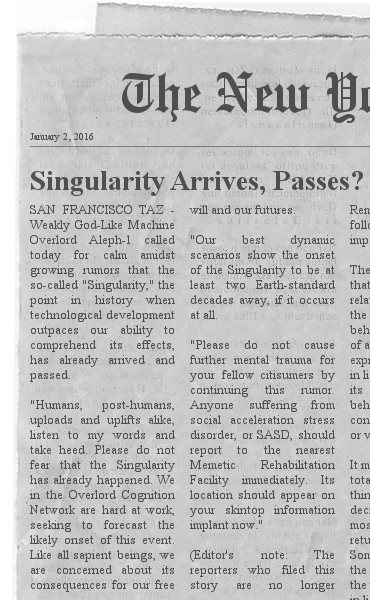
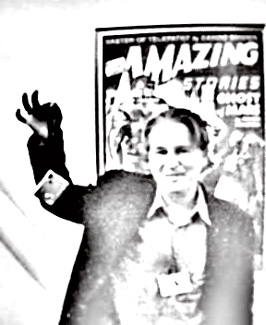 Bruce Sterling has kicked off his annual "
Bruce Sterling has kicked off his annual "
